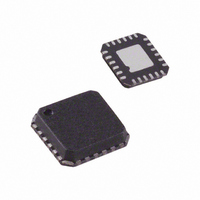ADF4360-2BCPZ Analog Devices Inc, ADF4360-2BCPZ Datasheet - Page 22

ADF4360-2BCPZ
Manufacturer Part Number
ADF4360-2BCPZ
Description
IC SYNTHESIZER/VCO 24-LFCSP
Manufacturer
Analog Devices Inc
Type
Fanout Distribution, Integer N Synthesizer (RF)r
Datasheet
1.ADF4360-2BCPZ.pdf
(24 pages)
Specifications of ADF4360-2BCPZ
Pll
Yes
Input
CMOS
Output
Clock
Number Of Circuits
1
Ratio - Input:output
1:2
Differential - Input:output
No/No
Frequency - Max
2.17GHz
Divider/multiplier
Yes/No
Voltage - Supply
3 V ~ 3.6 V
Operating Temperature
-40°C ~ 85°C
Mounting Type
Surface Mount
Package / Case
24-LFCSP
Frequency-max
2.15GHz
Pll Type
Frequency Synthesis
Frequency
2.17GHz
Supply Current
10mA
Supply Voltage Range
3V To 3.6V
Digital Ic Case Style
LFCSP
No. Of Pins
24
Operating Temperature Range
-40°C To +85°C
Lead Free Status / RoHS Status
Lead free / RoHS Compliant
For Use With
EVAL-ADF4360-2EBZ1 - BOARD EVALUATION FOR ADF4360-2
Lead Free Status / RoHS Status
Lead free / RoHS Compliant, Lead free / RoHS Compliant
Available stocks
Company
Part Number
Manufacturer
Quantity
Price
Part Number:
ADF4360-2BCPZ
Manufacturer:
ADI/亚德诺
Quantity:
20 000
Company:
Part Number:
ADF4360-2BCPZRL7
Manufacturer:
AD
Quantity:
7 500
Part Number:
ADF4360-2BCPZRL7
Manufacturer:
ADI/亚德诺
Quantity:
20 000
ADF4360-2
PCB DESIGN GUIDELINES FOR CHIP SCALE PACKAGE
The leads on the chip scale package (CP-24) are rectangular.
The printed circuit board pad for these should be 0.1 mm
longer than the package lead length and 0.05 mm wider than
the package lead width. The lead should be centered on the pad
to ensure that the solder joint size is maximized.
The bottom of the chip scale package has a central thermal pad.
The thermal pad on the printed circuit board should be at least
as large as this exposed pad. On the printed circuit board, there
should be a clearance of at least 0.25 mm between the thermal
pad and the inner edges of the pad pattern to ensure that
shorting is avoided.
Thermal vias can be used on the printed circuit board thermal
pad to improve thermal performance of the package. If vias are
used, they should be incorporated into the thermal pad at a
1.2 mm pitch grid. The via diameter should be between 0.3 mm
and 0.33 mm, and the via barrel should be plated with 1 ounce
of copper to plug the via.
The user should connect the printed circuit thermal pad to
AGND. This is internally connected to AGND.
OUTPUT MATCHING
There are a number of ways to match the output of the
ADF4360-2 for optimum operation; the most basic is to use a
50 Ω resistor to V
connected in series, as shown in Figure 21. Because the resistor
is not frequency dependent, this provides a good broadband
match. The output power in this circuit typically gives −6 dBm
output power into a 50 Ω load.
A better solution is to use a shunt inductor (acting as an RF
choke) to V
output power. Additionally, a series inductor is added after the
dc bypass capacitor to provide a resonant LC circuit. This tunes
the oscillator output and provides approximately 10 dB
additional rejection of the second harmonic. The shunt
inductor needs to be a relatively high value (>40 nH).
VCO.
Figure 21. Simple ADF4360-2 Output Stage
This gives a better match and, therefore, more
RF
VCO
V
VCO
OUT
. A dc bypass capacitor of 100 pF is
51Ω
100pF
50Ω
Rev. B | Page 22 of 24
Experiments have shown that the circuit shown in Figure 22
provides an excellent match to 50 Ω over the operating range of
the ADF4360-2. This gives approximately −3 dBm output
power across the frequency range of the ADF4360-2. Both
single-ended architectures can be examined using the
EVAL-ADF4360-2EB1 evaluation board.
If the user does not need the differential outputs available on
the ADF4360-2, the user can either terminate the unused
output or combine both outputs using a balun. The circuit in
Figure 23 shows how best to combine the outputs.
The circuit in Figure 23 is a lumped-lattice-type LC balun. It is
designed for a center frequency of 2.0 GHz and outputs 2.0 dBm at
this frequency. The series 2.2 nH inductor is used to tune out
any parasitic capacitance due to the board layout from each
input, and the remainder of the circuit is used to shift the
output of one RF input by +90° and the second by −90°, thus
combining the two. The action of the 3.6 nH inductor and the
1.8 pF capacitor accomplishes this. The 47 nH is used to
provide an RF choke to feed the supply voltage, and the 10 pF
capacitor provides the necessary dc block. To ensure good RF
performance, the circuits in Figure 22 and Figure 23 are
implemented with Coilcraft 0402/0603 inductors and AVX 0402
thin-film capacitors.
Alternatively, instead of the LC balun shown in Figure 23, both
outputs can be combined using a 180° rat-race coupler.
Figure 23. Balun for Combining ADF4360-2 RF Outputs
RF
RF
Figure 22. Optimum ADF4360-2 Output Stage
OUT
OUT
B
A
RF
V
VCO
OUT
2.2nH
2.2nH
V
VCO
47nH
1.8pF
3.6nH
1.8pF
3.6nH
1.8pF
3.6nH
47nH
50Ω
10pF
50Ω






